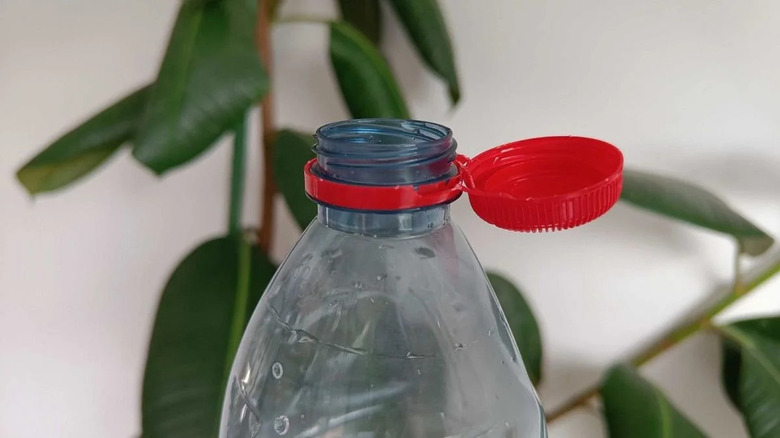This Unusual Plastic Bottle Feature In Europe Is Wildly Controversial Among Tourists
There's a new debate taking the online world by storm — and this time, it's European plastic bottles that have found themselves at the center of the controversy. Beyond Americans questioning why there are full water bottles sitting outside of houses in Italy or why it's so difficult to get free water at Spanish restaurants, this conversation has taken a more design-focused turn.
According to a series of TikTok videos and Reddit threads that have been making the rounds, locals and tourists alike have been pointing out — and arguing over — a divisive new feature on European plastic bottles: the cap is now permanently attached to the mouth of the bottle. And while some users like TikToker @kailawenn called the whole development "ingenious" and questioned why U.S. companies aren't doing the same, other bottled-drink enthusiasts weren't so happy about the change. Some people, like @tomfgoodwin on X (formerly known as Twitter), have even gone as far as to call it "the second worst idea the EU has had in the last 10 years."
So, what's the whole point of tethering the cap to the bottle besides sending people into a fit of rage? Put simply, it's just one step in a long list of new measures implemented by the EU in order to cut back on single-use plastic pollution for good.
Why is the cap attached to the bottle?
The decision to connect water bottles to their caps comes after a 2019 mandate by the European Commission that called on all EU nations to work toward reducing single-use plastic waste and marine pollution. Per the directive, beverage containers, along with nine other single-use plastic items, make up around 86% of the waste that's littered around EU beaches — and are therefore directly contributing to environmental degradation.
With that in mind, EU officials hope that attaching the cap to its bottle will encourage people to dispose of both items correctly instead of just dumping the smaller item on the ground. And with member states expected to comply with these measures by July 3, 2024 for bottles under 3 liters (the equivalent to about 101 ounces), it makes sense that there's more of these bottle caps out there at the moment — and that even more people, especially tourists flocking to Europe in summer 2024 are finally starting to notice the switch.
As for complaints from locals and tourists that the tethered cap makes it "impossible" to drink and pour from the bottle because it keeps getting in the way, only time will tell whether or not the slight inconvenience is worth it for the sake of the planet in the long run.

